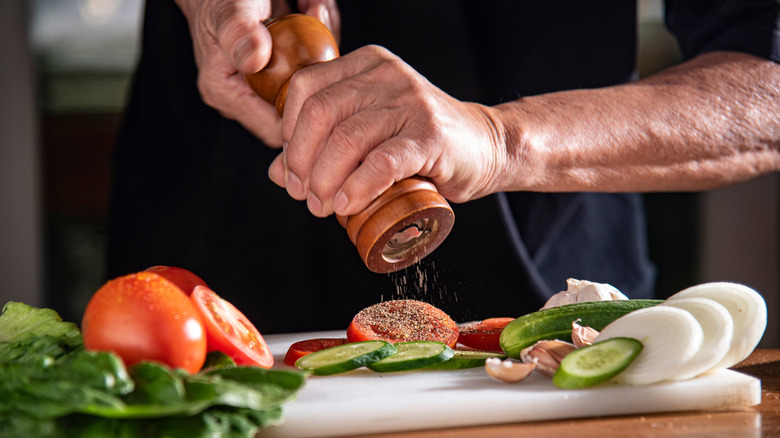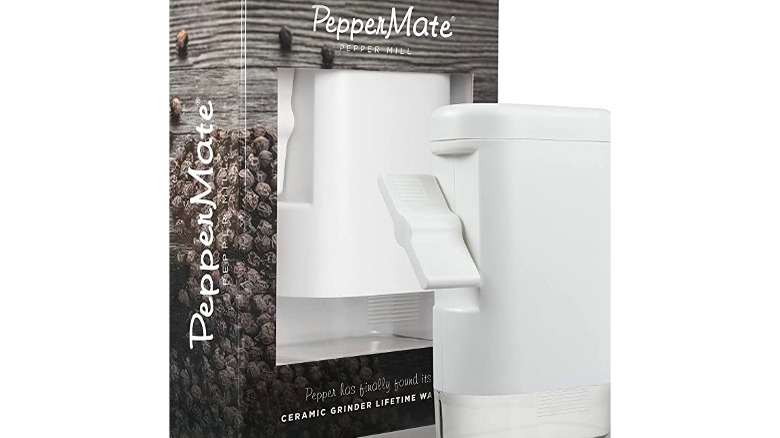Ina Garten Is Bringing Old-Fashioned Pepper Mills Back
One of the many reasons we love Ina Garten is that the celebrity chef feels like someone we could be friends with — blissfully sipping Cosmos, surrounded by hydrangeas while listening to what she made Jeffrey for dinner last weekend. Aside from her unbelievable kitchen/home in the Hamptons, as a home cook and host, Garten is relatable. Yes, she surrounds herself with the best quality, but not necessarily the most expensive ingredients or products, and shares what she likes with her fans.
When Garten posted a video on Instagram making the homemade croutons featured in her cookbook, "Cook Like a Pro" (which she ate piping hot out of the skillet, just like we would), a viewer asked about her pepper mill. Garten replied, "My pepper mill is called PepperMate, and it's the best."
If you've watched enough cooking shows, you've been told that freshly ground black pepper is better than purchasing pre-ground, but you may not know why that's true and equally important; why is the PepperMate the best tool for the job?
The argument for freshly ground black pepper
Known for its heat, black pepper adds more to food than just a sharp bite. When freshly ground, the aroma triggers our salivary glands and prepares the body for digestion, enhancing our experience and how the food tastes, which doesn't happen with pre-ground pepper.
After six months in the pantry, most dried spices become flat and lose their potency, requiring double the amount to do the same job, whereas freshly ground whole spices are aromatic and have a shelf life of up to five years. Even as they reach their expiration date, whole spices can be toasted and then ground to revive their flavor. Ground pepper starts to lose its flavor and aroma almost immediately once its shell is broken, which is why we should follow Garten's lead and freshly grind pepper for all our recipes. It's also why good restaurants offer to grind it freshly at the table instead of leaving a shaker.
Since the mid-1800s, when Peugeot introduced its pepper mill, manufacturers have played around with the design, offering models with a knob twist, crank, ratchet, or motor. Still, they all use gravity to feed peppercorns into a grinding mechanism similar to a coffee grinder. What separates the different models, aside from color and style, is its durability (will it last a lifetime), ease of use, and whether it's adjustable.
Ina's favorite pepper mill
Pepper mills retail between $3 to over $1,000 for crystal versions. Garten's pepper mill de jour, PepperMate, retails for under $40 and naturally comes in white, like everything else in her kitchen. If you're in the market for a pepper mill, look for one with ceramic, high-carbon, or steel mechanisms that are more durable than cheaper plastic versions.
Invest in a pepper mill with an adjustable dial to change the grind's coarseness. This feature gives cooks the versatility to coarsely grind pepper for steak au poivre or finely for a salad. Most adjustable models are controlled by a screw on the top of the cap, which loosens over time as you twist the knob. Models like PepperMate have a knob on the side, not connected to the grinding dial, which means it stays where you set it, requiring fewer adjustments.
In Garten's "60 Minutes" interview on CBS, the Barefoot Contessa shared that she measures every ingredient, even for her own recipes — including the half a teaspoon of salt and pepper, which may be another reason Garten loves this pepper mill. PepperMate has a clear cap that doubles as a measuring cup, which is a nice feature when you want to be exact.
The most apparent advantage PepperMate has over traditional models is its large opening for loading peppercorns. Most versions require a small funnel to refill the narrow chamber and send rogue peppercorns all over the kitchen. It looks like Garten did her homework.



